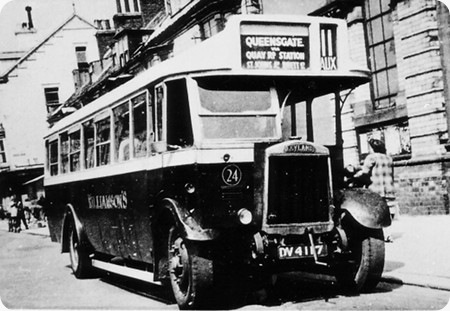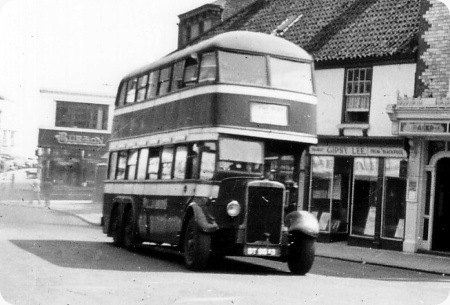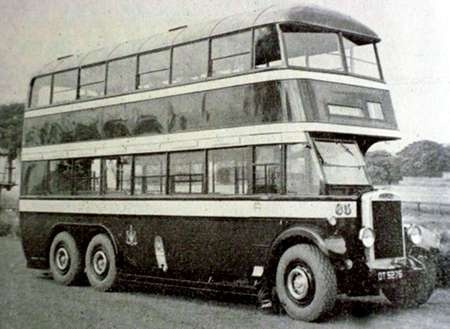Williamson’s - Leyland Lion - DV 4117 - 24

A George H Bullock photograph (courtesy Roger Monk)
Williamson’s of Bridlington
1930
Leyland Lion LT1
Hall Lewis B32?
Here is a picture of one of my very favourite Williamson’s vehicles from when I was a child staying
frequently in Bridlington. Williamson’s fleet could always be relied upon to provide a wide variety of
real gems, and a particular fascination lay in the fact that only two buses were required at any time to
operate the basic town services, and yet the fleet was always considerably more generous in size than
seemed necessary.
DV 4117 was a 1930 Leyland Lion LT1 which had been Devon General number 155. The
well appointed body was by Hall Lewis, forerunners of Park Royal, and seated 32 passengers. I have to
admit that, despite having such vivid memories of the vehicle, I cannot positively recall the entrance
position. I have always had an idea that it had a rear door and also another one oddly set a little away
from the front, but the photo shows no clear evidence of this and I may well be wrong. Any confirmation
from a DG expert would be more than welcome.
It was one of only a very few Williamson buses to
carry fleet numbers and proudly sported number 24 on the front panel. In case anyone is impressed by the
route number "11 AUX" I should explain that this was undoubtedly a Devon General remainder
which presumably indicated a duplicate journey. The destination blind is quite magnificent, specifying
the ultimate point and no less than four intermediate landmarks. This may not appear too remarkable
until we consider that each of the two town services was only roughly one and a quarter miles in length
!!
In my later years, when I became more familiar with schedules compilation and economic
programming on a grand scale I began to realise how very generous Wiliamson’s allocations were. The
service to Old Town left Chapel Street at 00 and 30 minutes past the hour, took ten minutes to reach
"Burlington" Market Place, stood for five minutes,and then returned to "The Quay"
where a further five minutes could be had before the next departure. The Queensgate service ran to a
similar pattern at 15 and 45 minutes past from Town. It is certain that both services could reasonably
have been operated with just one vehicle and crew, thereby reducing costs by 50%. This could have been
achieved by the bus leaving Old Town immediately on arrival and returning to Town via Queensgate - this
would still have given five minutes recovery time in every half hour.
This little theory of mine
just demonstrates the World of difference between those leisurely civilised days and the current callous
profit only orientated climate in the Bus Industry. Thank goodness for the former circumstances, or we
should never have seen such wonderful fleets as abounded far and wide.
Photograph and Copy contributed by Chris Youhill
01/05/11 - 21:08
Well Chris, my fascination with Williamson and WBS is kept well alive by this
post. I remember the Lions, but had forgotten, or never knew from where they originated.
Or
was there only one?
I have the Park Royal book by TPC (Part 1) which includes these DG Lions,
but it is not immediately to hand. I will check up on their body layout as there are some photos
therein of the Hall Lewis variety. What wonderful nostalgic memories these Bridlington Independents
conjure up! Thanks
John Whitaker
02/05/11 - 12:57
Many thanks John, and any such confirmation of the doorway/s in DV 4117 will be most welcome. Williamson’s had only one other Leyland LT1 Lion, with Leyland body, HD 3773 ex Yorkshire Woollen District - so Bridlington’s flat avenues will have made an easy retirement after the mountainous territory around Dewsbury !!
Chris Youhill
02/05/11 - 12:59
The picture I have is of the batch of LT1s which started at 25, and these had front entrances.
John Whitaker
03/05/11 - 08:55
Glory Days - Devon General (p35) has a picture of 157 (DV 5119). An LT1/Hall Lewis, it clearly has two doorway configuration. p38 has a picture of a Park Royal coach from 21 -24, single door, but the caption refers to the new Park Royal’s first DG deliveries being of 20 LT2 with dual door bodywork. It leads one to believe the dual door was a DG standard at the time for service bus bodywork.
David Oldfield
03/05/11 - 16:38
When you look through the bus at the nearside windows, the second one is much narrower than the first and offside ones. It could well be the front entrance. A very good post, Chris.
Chris Hebbron
04/05/11 - 06:59
Many thanks indeed to John, David, and Chris H for such prompt and conclusive research into the doorway question. The bus, by the way is standing at the "weekday" terminus in Chapel Street, right outside the Methodist chapel. The stop pole was located in a "golf ball socket" in the pavement. As a mark of reverence which would not be found anywhere today, sadly, the pole was removed on Sundays to a similar socket in the pavement nearer to the Promenade junction. My mother who was in no way a bus enthusiast, other than from "A to B", must have become tired of my endless advices that DV 4117 was my favourite bus - and informed me that "DV" was Latin for "God Willing."
Chris Youhill
05/05/11 - 07:10
I am attempting to put my recently acquired knowledge of Williamson, and White
Bus Service into some sequence, time wise!. Thanks to Chris, I am now aware of several buses which
operated for WBS and Williamson, but with the latter, who had such generous timetabling
"freedom" how on earth did they manage to run such a large fleet? In the period I
remember, about 1944 to 1950, Williamson had 2 Doncaster 6 wheelers, these Lions, and the 2 ex YWD
TD2s. Were they all there at the same time? My memory is so mixed up! What would be the max. fleet
strength at this period, and did they operate beyond QUAY and OLD TOWN?
Also, did the Devon
General Lion come direct, or via another operator, as I have a feeling these LT1s were withdrawn
before WW2 broke out: ie; after a 10 year life span. I am no DG expert though, and would love to see
some acquisition dates for this fascinating little fleet. I have a great deal of nostalgia and
respect for EYMS, but what a pity they swallowed up these 2 delightful memory stimulators!
You
must have had hols in Brid at the same time as me Chris! Did you ever get to Morecambe, where more
of my childhood memories took root?
John Whitaker
06/05/11 - 06:50
Several questions there John, and the answers are quite complicated. Pretty
comprehensive fleet lists of Williamson’s and WBS appear in the PSV Circle East Yorkshire history
and if you would like copies of these Peter will give you my E mail address. There were no less than
five ex YWD TD2s, and the two ex Doncaster six wheel giants were the last buses bought by
Williamson’s. They had only the two Bridlington local services - The Quay and Queensgate, and Old
Town and The Quay - other than a very early but unprofitable foray (before our time I believe) to
Flamborough.
I have never actually holidayed in Morecambe, and have only visited for the day
very occasionally.
Chris Youhill
27/09/12 - 07:04
I cannot believe that I have just stumbled across this web-site. The times,
not recently, that I have searched for Williamson’s Buses.
The company was owned by my great
grandfather, and latterly his brother.
The family home was 1, West Street, Bridlington and I
believe that they had premises on Quay Road and "The Black Shed" on Hilderthorpe Road (?).
I understand that they started with horse drawn hansom cabs and then horse drawn buses.
Apparently they kept a lot of horses on the fields that were then behind the West Street
house.
Jonathan Williamson
28/09/12 - 07:59
Jonathan - I’m so glad that you’ve been interested by this topic, and Williamson’s buses and those of the other Bridlington area operators were my life interest in the 1940s. The operating base was in Havelock Crescent in the final years - the premises still exist and are now a "Bosch" auto electrical concern. I have a cherished kindly letter from the last member of your family to run the business, regretting that he couldn’t help with any documents in answer to my appeal.
Chris Youhill
24/06/13 - 08:41
I’m so pleased to find this site and the photo of the Williamson bus. My Gt Gt
Grandfather John Williamson was the founder of the bus company in the late 19th century. John had a
large family and most of his sons were involved in the business. One had a livery stable, another
was a horse dealer with the beach donkeys as a side line. My Father said the Williamson horses
pulled the life-boat too.
The first motorised bus in Bridlington in 1922 was a Williamson bus.
After the death of John Williamson, Reuben Williamson (John’s youngest son took over the business.)
I have photos of the horse drawn buses if you are interested.
Cathy Goldthorpe
25/09/14 - 06:54
Cathy Goldthorpe and Jonathan Williamsons.
As the Williamsons blood runs
through many veins on our side of the family not only in Goole, including Doncaster, Hessle,
Castleford, Scunthorpe, Howden, Old Goole, Hull. Our side of the family was our mother Kathleen
Williamsons who left Bridlington for Howden in the early 1930s along with her sister Mayvene who
went to Doncaster.
As children I can remember our yearly visit to Bridlington to visit our
grandmother Eva at 28 Havelock Crescent with the garage opposite, my older brother and I would go
into the garage to play on the Double Deckers Buses running up and down the stairs this was around
the late 40s early 50s.
Great Grandma Emma would visit us at Goole in her Car a Lincoln
Zephyr, I was at the Bridlington library when Williamsons and the White Bus Companies was discussed
I found the meeting we had was very entertaining I would like to thank the organisers for putting
this show together thanks again.
N Roberts
26/09/14 - 05:39
I see that my relations have got here first. I was living in 2 West St as a child and was brought up on tales of Robert and Reuben Williamson, the horse buses and the White Bus co.. Nice to see all the information here.
David Gilson
20/10/15 - 06:55
Bit late arriving back to look here but thank you for the comments about the Library day, it was I who did the talk, after finishing the prep for Dad’s second book. I hope the library is able to do another one some time, I would love to go. I think I have possibly found a photo amongst those given to my dad by one of the elder Williamsons, showing the Lincoln Zephyr you mention!
Matt Gibbs
 Vehicle reminder shot for this posting
Vehicle reminder shot for this posting
19/08/21 - 06:41
In respect of JP registrations from Wigan, we had in the family a Wolseley Hornet registered, from new, JP 95, owned by my uncle from Chorley. The car was scrapped when he bought an Austin 16, and when, in the early 60s, he bought a Bentley R-type he tried to recover the registration as the Wolseley’s last owner, the authorities would not play ball. I still have the Bentley.
Johnfromstaffs
Quick links to the - Comments Page - Contact Page - Home Page


